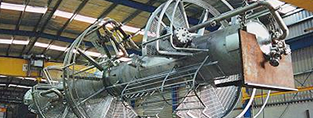
- (03) 5909 8218
- enquiry@fusionweld.com.au
Primary Design Considerations in Pressure Vessels
October 13, 2017

It's time to fill up a blank sheet of draughting paper with some thoughts on structural engineering, which means we're about to occupy our minds with pressure vessel design considerations. Furthermore, these are primary design concepts, plus their applications in practical fluid storage situations, not the kind of features and functions that demonstrate auxiliary workings. We begin with those material characteristics, with the alloys and heat treatment techniques that contain the fluids.
Waxing Familiar with Material Design Characteristics
Regardless of the design, of the braced innards and code-regulated fabrication technology, the pressure vessel isn't going to hold for long if it's not built from a durable metal alloy. Tough duplex steels coopt advanced heat treatment techniques steels so that the alloy provides resilient strength when internal pressures and temperatures torture the rolled metal. Incidentally, that rolling technique uniformly produces a specified wall thickness, as mandated by the design engineer and ASME codes. Anyway, at this point, we've got a stack of plate steel, plus the vessel design criteria. What function does the vessel serve? Is this a constant pressure situation or a processing environment that uses state-altering transient changes? Significant material changes are mandated if the metal is to withstand heat and pressure stress, plus the exterior threats presented by the environment. Again, heat treatment work accommodates this requirement.
Facilitating Fabrication Assembling Techniques
The orientation of the pressure vessel is determined by the processing layout and the properties of the fluid. Design conventions typically call upon a standard cylindrical shape, but even that standardized design requires intelligent forethought. There are diameter ratios and fluid distribution graphs that simplify the shape, but there are also phase separation mechanisms that push that work back towards the complex side of the design spectrum. Next, what about the end segments that enclose the cylinder? Hemispheroidal end segments and torispherical caps represent two popular pressure vessel end segments, with the hemispheroidal caps adding more volume to the end product. Simpler designs are favoured, though, for welds are less troublesome if the design lacks complex features.
For such a simple looking piece of apparatus, there's a lot going on during the design work. Also of importance, the weld techniques used to turn those discrete rolled metal segments into a single robust pressure vessel must be properly validated. The weld joins should resist all pressure and temperature peaks. In point of fact, the seams should have an inbuilt overhead, a safety margin that exists to withstand a denoted pressure limit that pushes past the designed fluid handling rating. By building the pressure vessel with this overhead, it temporarily holds the overload until a pressure release valve can activate.
Contact Details
Fusion - Weld Engineering Pty Ltd
ABN 98 068 987619
1865 Frankston Flinders Road,
Hastings, VIC 3915
Ph: (03) 5909 8218
Optimized by NetwizardSEO.com.au
Recent Posts
- Compressed Hydrogen Storage Vessels: Material Selection, Design & Australian Standards
- Welding QA/QC in Oil & Gas Pressure Vessel Fabrication – Ensuring Code Compliance
- AS1210 vs ASME VIII Pressure Vessel Code: Key Differences for Australian Projects
- Mitigating Hydrogen-Induced Cracking in Pressure Vessels: Engineering and Material Strategies
- Storage Tank Solutions Australia: Field-Erected, Prefabricated & Self-Bunded Explained
- Reducing Environmental Risks: Self-Bunded Tanks in Australian Oil & Gas Operations
- Precision in Production: How Pressure Vessels Are Manufactured for Industrial Safety
- Shell & Tube Heat Exchangers: Improve Thermal Control & Energy Recovery in Petrochemical & Pharmaceutical Plants
- In-Service Inspection for Compressed Air Receivers for Power Plant Shutdown Prevention
- Power Plant Pipe Spooling Fabrication – Get Rapid, Code-Compliant Spools Ready for Installation
- Field Erected Tanks: Safe, Reliable On-Site Fuel Storage Solutions in Australia
- Custom Pressure Vessel Fabrication for Flammable Gases
Posts 2025
- Compressed Hydrogen Storage Vessels: Material Selection, Design & Australian Standards
- Welding QA/QC in Oil & Gas Pressure Vessel Fabrication – Ensuring Code Compliance
- View all articles…
Posts 2024
- Large Process Vessels: Optimising the Design for Maximum Efficiency [2025]
- Pressure Equipment Management System Installation: Detect Equipment Faults Early
- View all articles…
Posts 2023
- Pressure Piping System Inspection: A Gift of Safety for the Holidays
- Deaerator Inspections by Fusion-Weld Engineering and How They Reduce System Downtime
- View all articles…
Posts 2022
- How Fusion Weld Keeps Up With AS-NZS ISO 9001:2008 Standard
- Boiler Equipment Safety Inspection During the Summer Season
- View all articles…
Posts 2021
- Avoid These Factors and Practices that Contribute to Sealing Damage in Pressure Vessels
- Do's And Don'ts Of Industrial Boiler Inspection And Maintenance From Fusion-Weld
- View all articles…
Posts 2020
- What are the Risks and Hazards Involved in Pressure Vessel Equipment?
- How to Know if Your Pressure Equipment Needs Repair or Replacement?
- View all articles…
Posts 2019
- Factors that Contribute to Pressure Vessel Failure
- Pressure Vessel Regulations in Australia: What are the Mandatory Requirements?
- View all articles…
Posts 2018
- Pros and Cons of Spherical vs. Cylindrical Pressure Vessels
- What are the Different Hazard Levels in Pressure Vessels?
- View all articles…
Posts 2017
- Transportable Pressure Vessels: The Importance of Inspection and Safety Checks
- Fracture Mechanics and Stress Analysis of Cracks in Pressure Vessels
- View all articles…
Posts 2016
Posts 2015
- What Are Deaerators & Feedwater Vessels?
- Precautions and Safety for Compressed Air Receiver Vessels
- View all articles…
Posts 2014
- Demonstrating In-process Inspection Procedures
- Static Grounding Practices and Standards
- View all articles…